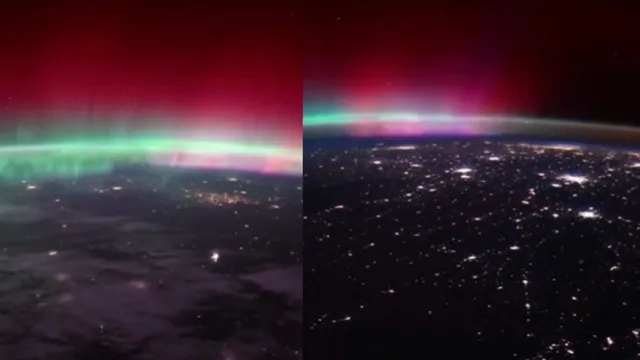- By Shivangi Sharma
- Mon, 24 Nov 2025 03:42 PM (IST)
- Source:JND
NASA astronaut Zena Cardman has captured the internet’s attention after sharing breathtaking footage of the aurora borealis as seen from the International Space Station (ISS) on 17 November. The glowing waves of green and purple light, normally witnessed from Earth’s polar regions, appeared even more surreal from orbit, unfolding beneath the station as it cruised hundreds of kilometres above the planet.
Cardman shot the video during what she called “orbital daytime”, a period when sunlight still touches parts of the Earth even as auroras shimmer below. The clip begins above the United States as the ISS drifts southwest. City lights from Houston, New Orleans, and the Florida peninsula sparkle through the darkness before the spectacular curtains of aurora light up the atmosphere.
“I’ve still never seen the aurora from below, but up here, it’s a frequent show,” she wrote while posting the video on X. “Last week’s was especially good.”
I’ve still never seen aurora from below, but up here, it’s a frequent show. Last week’s was especially good. See if you can spot Houston, Florida, and the northern lights all in one frame, before we head out across the Gulf and some great lightning storms over South America at… pic.twitter.com/THqX83wNXL
— Zena Cardman (@zenanaut) November 17, 2025
Spot The Cities From Space
Cardman also turned the post into a challenge for viewers. She encouraged them to identify Houston, Florida, and the Northern Lights in a single frame as the ISS glides across the Gulf of Mexico. The video continues onward toward South America, where lightning storms flash as sunrise forms a soft golden arc over the horizon, offering a stunning contrast between Earth’s natural light shows.
NASA confirmed that Cardman is the commander of the SpaceX Crew-11 mission, which launched on August 1, 2025. Besides her scientific duties, she has been regularly sharing mesmerizing images and videos of Earth, giving viewers a glimpse of what our planet looks like from orbit.
A Scientist With Deep Earth Experience
Before journeying into space, Cardman built a strong background in Earth and environmental sciences. She holds a bachelor’s degree in Biology and a master’s in Marine Sciences from the University of North Carolina at Chapel Hill. Her academic work has included studies of microbial systems in hydrocarbon seeps, hydrothermal vents, and the Arctic, reflecting her long-standing interest in extreme environments.
She has previously worked with the Palmer Long-Term Ecological Research group in Antarctica, contributed to NASA-supported studies in regions such as British Columbia, the Canadian High Arctic, Idaho, and Hawaii, and even served briefly as an assistant engineer for the Sea Education Association.

